The History of Siren Control Systems
The BT Archives contain a series of reports compiled by the GPO Engineer-in-Chief. These document the developments immediately post WW2 up to the development of a carrier system, which is described separately in this HANDEL section of the website. The most informative is the 1950-51 report.
During the last war, the P.O. was responsible for the design and development of a number of systems for the remote control of public air raid warning sirens from a central point.
In the immediate post war period, most of the equipment was scrapped but a certain amount of it was adopted, at the request of the Home Office, for the purpose of controlling bells and sirens used for calling out firemen in rural districts, thus dispensing with watchkeepers. The various systems developed for this purpose became known subsequently as Remote Control Systems A, B and C. They were all designed for operation over private circuits and were dependant upon the availability of A.C. mains supplies at the controlling points.
In the immediate post war period, most of the equipment was scrapped but a certain amount of it was adopted, at the request of the Home Office, for the purpose of controlling bells and sirens used for calling out firemen in rural districts, thus dispensing with watchkeepers. The various systems developed for this purpose became known subsequently as Remote Control Systems A, B and C. They were all designed for operation over private circuits and were dependant upon the availability of A.C. mains supplies at the controlling points.
Readers may not be aware that prior to the introduction of firemen's personal radio pagers in the seventies, retained staff had a bell fitted in their house to call them to the fire station to man the appliance. During daylight hours when they could be away from home a siren was used to make them aware of the callout. Retained stations are mainly in rural areas whereas major towns and cities have a full time crew on standby 24/7.
The report goes on to say: More recently, there have been a number of further developments to relieve the Fire Services of the burden of private circuit rentals and to secure independence of A.C. mains supplies at the controlling point. At about the same time, there was a pressing Home Office demand for a restoration of the public warning system.
In the light of experiences during the last war, it was decided that an improved method of control was essential. Various proposals were examined and the following is a summary of the main lines of the development.
In the light of experiences during the last war, it was decided that an improved method of control was essential. Various proposals were examined and the following is a summary of the main lines of the development.
System D
The 1950-51 report says: This system for controlling fire bells and sirens is intended, primarily, for villages served by automatic exchanges where the fire station is unattended. It provides for the remote operation of firemen's call bells and the operation of the "call-out" siren during the day. Calls are originated by an ordinary telephone call from an attended fire station and a special voice-frequency signal is transmitted.
Temporary equipment, made up from war surplus components, has given a useful degree of service in 50 experimental installations. A development contract has now been placed for a new and improved design to eliminate the weaknesses which came to light as the result of experience with the temporary equipment.
System DX
First mentioned in the 1951-52 E-i-C report: This new and improved design of System D is intended, primarily, for controlling firemen's call bells and sirens in small towns served by automatic exchanges. . . . A prototype system has been tried out successfully by the Fire Service, and Home Office approval has been given. An order for 200 systems has been placed.
System E
The operation is fully described in the topic below, but the 1950-51 E-i-C Report sheds light on its development. This is a new system which has been developed, and tried out successfully by the Metropolitan Police, for controlling air raid warning sirens. To avoid the production and maintenance difficulties inherent in the use of 100 c/s. signalling equipment as used in the war-time equipment, the system has been designed to use positive battery signalling. Continuous line test and answer-back facilities are provided, and safeguards against false operation by contact with other circuits, due to line faults, have been incorporated.
Before the sixties much of the line plant was carried on overhead poles using uninsulated copper wires. High winds and contact with trees could cause these wires to touch. While this may cause a telephone bell to tinkle annoyingly, it was undesirable for a similar fault to set a siren off especially if it didn't stop for hours.
The reference in the 1950-51 report to unreliability of the 100 c/s signalling for siren control during WW2 is borne out by a number of documents held in the BT Archives. These are research reports into improving certain components in the design made by the staff at the P.O. Research station at Dollis Hill. TCB/422/11222 titled "100 c/s Generator with Increased Output for Remote Control of Sirens" and TCB/422/11204 titled "Tuned Mercury Relays for the Remote Control of Air-raid Sirens" both dated January 1941. These are not particularly interesting documents, however the co-author is Mr T.H. Flowers, Tommy Flowers is the gentleman credited with designing the code breaking 'Colossus' computer at Bletchley Park. The Colossus Mk1 first ran at Dollis Hill in November 1943, 35 months later. Read about the great man of WW2 https://en.wikipedia.org/wiki/Tommy_Flowers
The next year the 1951-52 E-i-C Reports quotes: Pending the development of further air raid warning signals, the Home Office has decided to reinstate remote control systems to provide the 'Alert' and 'Raiders Passed' signals used during World War II. For this purpose, System E has been selected and manufacture is in hand. The necessary information for installing this system has been issued.
Installation progress is reported by the 1952-53 E-i-C Report: Most of the apparatus for System E (see last report, page 16) has now been manufactured. Installation is now proceeding throughout the United Kingdom on schemes down to Stage V of the national plan . . . . The Post Office part of the work has generally been well ahead of that for which local authorities are responsible. . . .
By the time of the 1953-54 Report, the development of the Carrier System is underway and thoughts move towards a national warning system, similar to Handel. The installation of the main program of Remote Control System E in the larger towns is now nearing completion and consideration is being given to meeting the requirements of smaller towns and villages. It is possible that a simplified, less expensive system will be adequate.
The requirements for an audio network to link System "E" and Carrier Distribution centres to the primary sources of information have been discussed with the Home Office and the operation of equipment which would be suitable for use in such a network has been demonstrated.
The primary source of the national warning is the Home Office, Warning Officer, co-located at the Air Defence Operations Centre, but this fact is not mentioned by the report.
System F
The 1950-51 report says, although this system was developed it sacrificed facilities of system 'E' and was rejected by the Home Office.
System G
The 1950-51 report describes the fire callout system: This is an alternative to System D for use in manual exchange areas only. The voice frequency signals used for system D are liable to interruption by manual exchange operators. At this time, there were many small manual exchanges still in service. It wasn't until the seventies that the last manual public exchange was replaced by an automatic system. The report goes on to say: An initial provision of 50 sets of equipment has been recommended pending a Home Office review of actual demand.
System K
Described in the 1950-51 report as: This is a new system designed to supersede Systems A, B and C for the control of firemen's call bells and sirens over private circuits. By using positive battery in lieu of 100c/s signalling, the system is made independent of the availability of A.C. mains. In those days, some places were still fed by D.C. mains supplies.
. . . . Opportunity has been taken to incorporate the various other facilities demanded by the Fire Services, e.g. speech over the private circuit (for reporting purposes), for dealing with calls originated by the public at the unattended station. . . Fire Stations have a telephone outside so the public can speak to the central Fire Service operator to make a Fire call. This is known as the running call telephone, as the unfortunate person would run to the Firestation to summon help. At that time very few members of the public had landline telephones and had to rely on public phone boxes.
By the time of the 1952-53 E-i-C report: manufacture is proceeding on the first order for equipment for this system, which for new work, will supersede the earlier systems based on the use of apparatus originally designed for air-raid warning purposes in the 1939-45 war.
System L
This is the last system described in the 1950-51 report: Certain sirens used during the last war were provided with shutters at both ends, each of which could be operated separately, to provide additional warning signals. These shutters were operated by D.C. signals
To meet the possibility that similar facilities might again be required, a modification of System E has been developed and is known as System L. This provides for an additional signalling path, without sacrificing the other facilities given by System E. Both shutters are closed simultaneously; to allow either to be closed separately, a third signalling path would be required and experimental work has started.
The 1951-52 report says: A prototype System L has successfully completed a trial by the Metropolitan Police. Experimental work to develop a system which will give facilities for the independent operation of two shutters as well as the siren motor is still in hand.
The simultaneous operation of both shutters were going to be used to give a 'Grey Warning' when fallout is expected in one hours time, but the idea was dropped and not included when HANDEL came along. Independent operation of each end will allow a two tone Dee-Dar-Dee-Dar sound, apparently used as the Broadmoor Hospital prisoner escape warning signal.
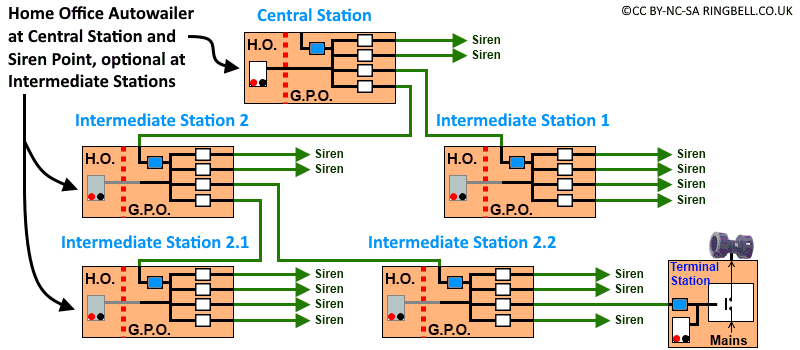
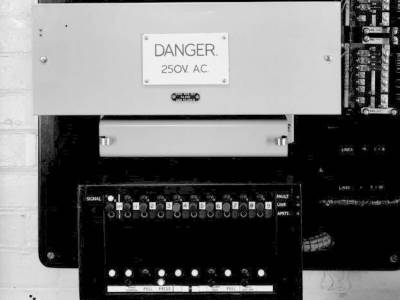
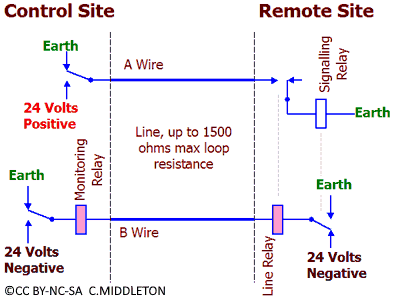
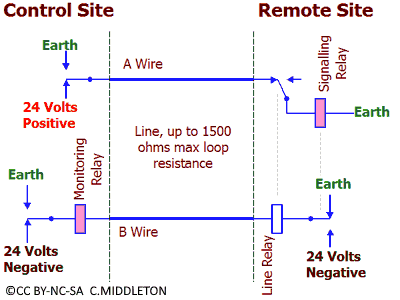
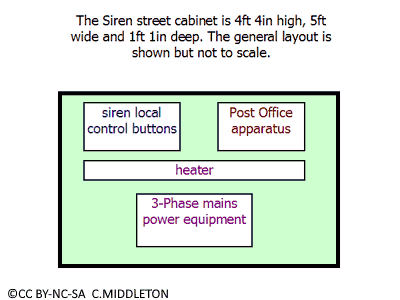
 The Images from BT Archives are Copyright BT Heritage, licensed under a
The Images from BT Archives are Copyright BT Heritage, licensed under a